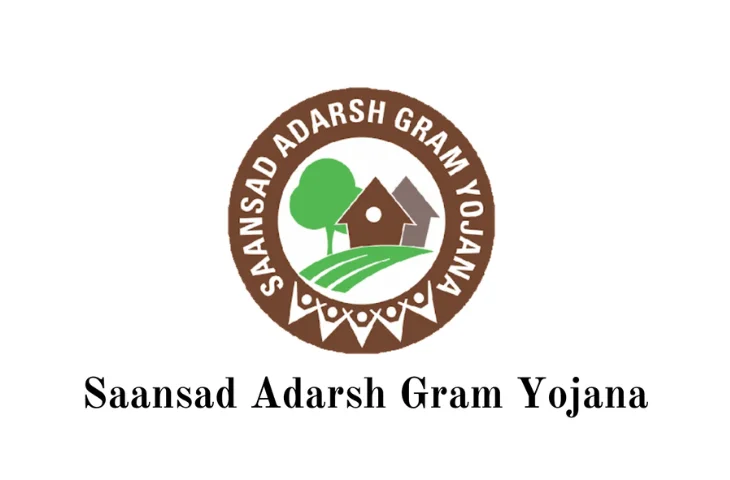The Sansad Adarsh Gram Yojana (SAGY) is a rural development initiative aimed at transforming selected villages into model Gram Panchayats. The scheme was launched on 11th October 2014 by Prime Minister Narendra Modi. It reflects Mahatma Gandhi’s vision of an ideal village, adapted to the modern context.
Under SAGY, each Member of Parliament (MP) adopts a Gram Panchayat and provides leadership for holistic development, ensuring equal focus on physical infrastructure and social development. These “Adarsh Grams” are intended to serve as schools of local development and governance, inspiring other villages to replicate successful models.
Why was Saansad Adarsh Gram Yojana Introduced?
India’s rural areas face multiple challenges including lack of basic amenities, limited access to education and health facilities, poor infrastructure, and social disparities. SAGY was introduced to:
- Demonstrate good governance and participatory development at the village level.
- Encourage community involvement in planning and implementation.
- Leverage MP leadership and resources for targeted and effective development.
- Provide model examples that other Gram Panchayats can learn from.
What are the Main Objectives of SAGY?
The scheme focuses on holistic village development, with the following key objectives:
- Improve living standards of villagers through better infrastructure, human development, and access to social services.
- Reduce disparities in rural areas by focusing on marginalized communities.
- Promote sustainable livelihoods and economic development opportunities.
- Develop model governance systems that are transparent, accountable, and participatory.
- Encourage social transformation by instilling values such as gender equality, dignity of labor, and community service.
What Values does Saansad Adarsh Gram Yojana Promote?
SAGY goes beyond mere infrastructure development. It emphasizes ethical, social, and environmental values to transform villages into exemplary communities:
- People’s participation: Ensuring all community members take part in decision-making.
- Antyodaya principle: Focusing on the welfare of the poorest and weakest individuals.
- Gender equality: Respecting women and promoting equality.
- Social justice: Ensuring fair treatment for all sections of society.
- Community service and voluntarism: Encouraging the spirit of helping others.
- Cleanliness and hygiene: Promoting sanitation and waste management.
- Sustainable development: Balancing ecological concerns with growth.
- Preservation of culture: Maintaining and promoting local traditions.
- Mutual cooperation and self-reliance: Strengthening community bonds.
- Peace and harmony: Fostering peaceful coexistence in villages.
- Transparency and accountability: Upholding integrity in governance.
- Local self-governance: Strengthening Gram Panchayats’ capacity.
- Constitutional values: Adhering to Fundamental Rights and Duties.
Also Check: List of Government Schemes of India
How does SAGY Work?
SAGY operates on a demand-driven and participatory model, involving multiple stakeholders. Its implementation involves:
| Section | Key Points |
| 1. Selection of Gram Panchayats | – Basic unit is a Gram Panchayat. – Population criteria: Plain areas: 3,000–5,000; Hilly/tribal/difficult areas: 1,000–3,000. – MPs select one village immediately and two more later. – Lok Sabha MPs choose from their constituency; Rajya Sabha MPs from their State. – In urban constituencies, MPs select nearby rural villages. |
| 2. Development Plan | – MPs lead preparation of Village Development Plan (VDP) with villagers’ input. – Plan covers infrastructure, education, health, livelihoods, social security, environment, and governance. |
| 3. Convergence of Schemes | – SAGY does not allocate new funds; uses existing government schemes and private initiatives. – Line departments, voluntary organizations, and research institutions collaborate to implement programs. |
| 4. Institutional Framework | – District Collector: Nodal officer, ensures convergence, conducts monthly review meetings, grievance redressal. – Gram Panchayat: Implements activities and mobilizes community participation. – Member of Parliament: Facilitates planning, monitors progress, mobilizes additional resources. – National Committees: Monitor development and issue operational guidance. |
Check Out: Complete List of Important Schemes for NABARD Grade A Exam
What are the Major Components of an Adarsh Gram?
The components of an Adarsh Gram depend on local context but broadly include:
| Component | Key Points |
| Infrastructure Development | Roads, electricity, sanitation, water supply, street lighting, broadband, and telecommunication. |
| Education | Smart schools, e-literacy, libraries, adult education, and school retention programs. |
| Healthcare | Universal access to primary health facilities, immunization, nutrition for women and children, institutional delivery. |
| Economic and Livelihood Development | Agriculture and allied activities, organic farming, soil health management, micro-irrigation, livestock development, agro-processing, village tourism; skill development and micro-enterprises for youth. |
| Social Development | Voluntarism, celebration of village festivals, honoring elders, inclusion of marginalized groups, promoting local culture. |
| Environmental Sustainability | Waste management, tree plantations, water conservation, social forestry, pollution control, rooftop rainwater harvesting. |
| Social Security | Pensions, insurance schemes, health coverage, universal PDS access. |
| Good Governance | Strong Gram Panchayats, regular Gram Sabhas, Mahila and Bal Sabhas, e-governance, grievance redressal, transparency, accountability. |
| Use of Technology | Mobile-based applications, remote sensing, agricultural technologies, road and construction innovations, water and sanitation technologies. |
How Many Villages have been Adopted Under Saansad Adarsh Gram Yojana?
Since its inception, 3,390 Gram Panchayats have been identified under SAGY across all States and Union Territories. Some examples include:
| State/UT | No. of GPs Adopted |
| Uttar Pradesh | 549 |
| Tamil Nadu | 367 |
| Maharashtra | 260 |
| Gujarat | 234 |
| Bihar | 197 |
Get ready to crack government job exams with leading educators
What are the Challenges of SAGY?
Challenges faced while implementing SAGY are as follows:
- Lack of dedicated funds limits the Sarpanch’s ability to initiate work.
- Coordination across multiple ministries is complex.
- MPs need platforms to monitor development effectively.
- Knowledge gaps about various schemes can delay implementation.
- MPs cannot select their village or spouse’s village, creating political and logistical challenges.
What are the Outcomes and Impact of SAGY?
SAGY aims to achieve measurable improvements in quality of life and social cohesion. Key expected outcomes include:
- Enhanced livelihoods and employment opportunities.
- Reduction in distress migration and poverty.
- Elimination of child labor, bonded labor, and manual scavenging.
- 100% registration of births and deaths.
- Establishment of alternative dispute resolution systems.
- Promotion of peace, harmony, and social cohesion.
- Creation of demonstrable models for other Gram Panchayats.
Key Takeaways
| Parameter | Details |
| Scheme Name | Sansad Adarsh Gram Yojana (SAGY) |
| Launch Date | 11 October 2014 |
| Objective | Holistic development of Gram Panchayats |
| Implementing Authority | Ministry of Rural Development |
| Beneficiaries | Villagers in adopted Gram Panchayats |
| Role of MP | Adopt village, lead development, mobilize funds, monitor progress |
| Key Features | Participatory planning, convergence of schemes, values-based development |
| Target | 3 model villages by 2019, 5 by 2024 |
| Number of Villages Adopted | 3,390 GPs across India |
| Focus Areas | Infrastructure, education, health, livelihoods, social security, environment, governance |
Questions Based on Sansad Adarsh Gram Yojana (SAGY)
- When was SAGY launched?
a) 26 January 2015
b) 15 August 2014
c) 11 October 2014
d) 2 October 2014
e) 1 January 2015 - What is the primary unit under SAGY?
a) District
b) State
c) Gram Panchayat
d) Block
e) Municipality - How many model villages were targeted to be developed by 2019?
a) 1
b) 3
c) 5
d) 10
e) 7 - Which value is NOT directly promoted by SAGY?
a) Gender equality
b) Transparency
c) Dignity of labor
d) Urbanization
e) Social justice - Who acts as the nodal officer for SAGY at the district level?
a) MP
b) Block Development Officer
c) District Collector
d) Sarpanch
e) Gram Sabha - Which MP is eligible to select a Gram Panchayat outside their constituency?
a) Lok Sabha MP
b) Rajya Sabha MP
c) Municipal MP
d) All MPs
e) None - Which of these is a component of an Adarsh Gram?
a) Healthcare
b) Road construction
c) Skill development
d) Social security
e) All of the above - How many Gram Panchayats have been adopted under SAGY till now?
a) 1,000
b) 2,500
c) 3,390
d) 4,000
e) 5,000 - Which principle ensures the welfare of the poorest villagers?
a) Swachh Bharat
b) Antyodaya
c) Panchayati Raj
d) Digital India
e) Skill India - Which of the following is a major challenge of SAGY?
a) Lack of MP involvement
b) Coordination across ministries
c) Absence of rural areas
d) Overfunding
e) None of the above
Also Read:
Answer Key
| Question No. | Correct Answer |
| 1 | c) 11 October 2014 |
| 2 | c) Gram Panchayat |
| 3 | b) 3 |
| 4 | d) Urbanization |
| 5 | c) District Collector |
| 6 | b) Rajya Sabha MP |
| 7 | e) All of the above |
| 8 | c) 3,390 |
| 9 | b) Antyodaya |
| 10 | b) Coordination across ministries |
- MISHTI Scheme, India’s Initiative to Restore Mangrove Ecosystems
- National Green Hydrogen Mission Features, Objectives, and Benefits
- Paramparagat Krishi Vikas Yojana, Transforming India’s Organic Farming
- Mission on Integrated Development of Horticulture NHM and HMNEH
- Swachh Bharat Mission, India’s Journey Towards Cleanliness and Hygiene
- SAGY, A Step Towards Holistic Development of Indian Villages

Priti Palit, is an accomplished edtech writer with 4+ years of experience in Regulatory Exams and other multiple government exams. With a passion for education and a keen eye for detail, she has contributed significantly to the field of online learning. Priti’s expertise and dedication continue to empower aspiring individuals in their pursuit of success in government examinations.
